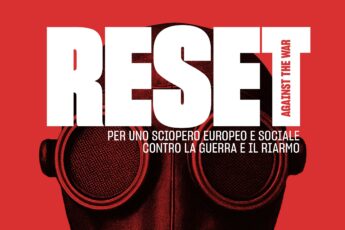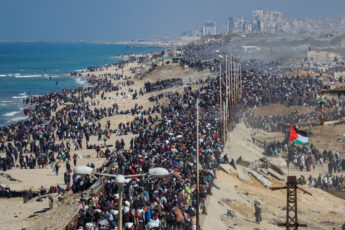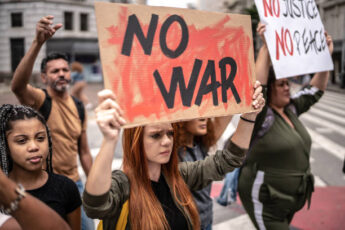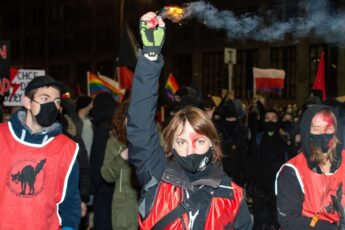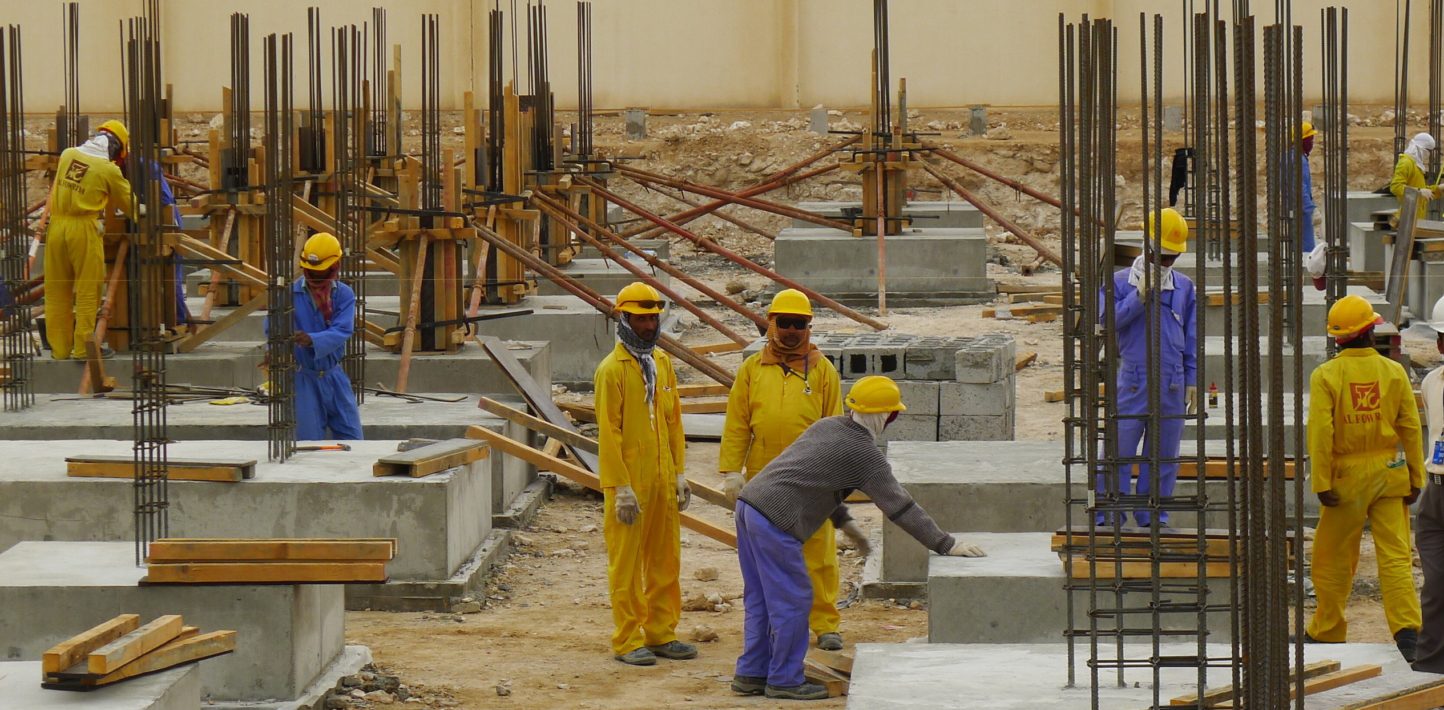
Giorgio Grappi
via ∫connessioni precarie (ITA)
The web of value
The Financial Times recently broke the news that the Tony Blair Foundation had been involved in a series of email exchanges discussing details of the Gaza Riviera project, and this was then picked up by global media outlets. The idea of transforming the Gaza Strip into a tourist, commercial, and manufacturing hub has become public knowledge, partly thanks to Trump sharing an AI-generated satirical video created by two video makers to test a new model during a coffee break. However, in Israel, the Gaza 2035 project has been under discussion for some time. The Times provides details of the project, including the adoption of ‘development’ schemes drawn up by the Boston Consulting Group. Members of this consulting firm were involved in defining the Gaza Humanitarian Foundation’s military food distribution plan, as well as discussing tools for the ‘transfer’ of hundreds of thousands of Palestinians.
As grotesque as it may seem in light of the ongoing genocide, the Gaza Riviera scenario must be taken seriously for what it represents and the context in which it exists. In particular, it is consistent with economic development models of recent decades, particularly those linked to the planning of New Towns, whose conception and aesthetics are reproduced in the images published by the Financial Times. Furthermore, the idea of turning Gaza into an economic El Dorado forms part of a broader scheme that follows what we might call the “corridor policy”, which has already been seen at work in other areas of the planet. The Riviera would, in fact, be located within the IMEC (India-Middle East-Europe Corridor) corridor’s area of influence. This corridor is designed to reshape the value landscape between Asia, the Persian Gulf, and Europe, during an era of intense competition, driven by Chinese infrastructure and digital capitalism, and characterized by the proliferation of projects that form an interconnected web where economic initiatives and geopolitical calculations converge. The corollary of such spatial reimagination of the region is the Abraham Accords between Israel, the United Arab Emirates, and Bahrain — the starting point for the supposed normalization of relations and the creation of the new economic area.
The Abraham Accords and the IMEC project did not emerge from the mind of some obscure bureaucrat; they played a significant role at the G20 summit held in India in September 2023. On the sidelines of this summit, the United States, the EU (in particular Germany, France, and Italy), the United Kingdom, India, Saudi Arabia, and the United Arab Emirates signed a memorandum of understanding, which was hailed as one of the summit’s main achievements.
To become an actual project, the idea of IMEC and Gaza Riviera today must confront the more than two million Palestinians living in the Strip, the remnants of Hamas, and diverging interests among the involved parties. However, these few references should suffice to illustrate that the 7 October attack and the subsequent devastating war in Gaza cannot be viewed as merely another chapter in a decades-long conflict. Instead, they must be considered as the manifestation of that conflict within new dynamics that shape its nature and significance. What is happening today in the Strip and the West Bank, where 7 October marked an acceleration in the systematic dismantling of Palestinian territories, is of course rooted in a long history that has been frequently recalled in recent months. However, it is crucial to recognize the current situation and contextualize it within the broader framework of transnational disorder and the reorganization of capital that defines the present era. There is no need to dwell on the Palestinian military action that triggered this new phase, except to recall that unhesitatingly condemning Israeli conduct does not negate the fact that discussion on the issue remains relevant for anyone intending to contribute to constructing a liberation movement capable of ending the suffering that war imposes on living labor. Rather, we should question how the massacre in Gaza transcends its traditional boundaries.
An indication of this was provided by Israeli Prime Minister Netanyahu himself when, at the UN Security Council in September 2024, he presented two contrasting maps: one depicting the “curse” of the region led by Iran and its allies, and the other depicting the “blessing” which simplistically mirrored the IMEC plan. The absence of Palestine from these maps caused a stir, but they made clear what was previously implicit: the implementation of this vision as a driver for win-win economic growth requires the political and territorial reorganization of the region. Today, we can see how the prospect of this reorganization took a decisive leap forward on 7 October, just a few days after the IMEC’s triumphant announcement. The war in Gaza, with its protracted nature, has simultaneously slowed down and made more realistic the idea of redefining the value networks between Europe and Southeast Asia.
Outside exceptionalism
Of course, linking the genocide in Gaza to regional “development£ projects also serves the Israeli government’s propaganda and instrumental purposes. This is not to relativize what we are witnessing in Gaza, however: the genocide must be stopped, and the enormity of the crimes committed by the IDF and its military and financial supporters is clear. The war’s immediate result is Israeli territorial expansion at the expense of Palestinian territory and lives. However, without considering this context, it is difficult to comprehend the mild reactions that have accompanied the ongoing massacre, which shows no respect for international conventions.
It should be clarified that referring to projects such as IMEC does not imply a coherent plan, but rather an effective trend that mobilizes imaginaries and perspectives, producing relationships and interests that orient actions and partial convergences between fractions of capital and political-institutional actors. The framework of these interests is broad and varied and is closely linked to changing political conditions. Two very concrete examples are the port of Haifa, which is now owned by the Indian Adani Group and is considered an outpost of India’s new geo-economic projection, where the shots fired by Iran during the ’12-day war’, which also fell near the port area, caused considerable concern. Closer to home, we have the port of Trieste, whose strategic role in the context of IMEC was relaunched just a few weeks ago by the Friuli Venezia Giulia Region and the Ministry of Economy.
Therefore, we must ask ourselves why, at a time when conflicts seem to be sweeping away the idea of globalization — not least Trump’s tariffs — the notion of the spatial organization of the world market is resisting and re-emerging in this form. My hypothesis is that, in the context of the disorder that characterizes international relations today, war is not only an impediment to the future scenarios described in master plans and memoranda; it is also one of the factors that determine their development, both spatially and in terms of the processes set in motion. Competition surrounding projects for the reorganization of products, technologies, and geoeconomics creates a field of tension that, while never leading to their complete realization, expresses the intertwining of the savage dimension of capital and its ever-necessary grounding, as well as the territorial policies of states and their projections onto the global stage. Therefore, it is not a question of replacing geopolitics with geoeconomics, but of taking it a step further. Rather than being a preview of future orders, as their promoters always suggest, the scenarios put forward by these projects must be understood for the effects they have during their implementation.
This dimension acquires even greater significance in the context of war, which establishes new areas of exploitation free from the constraints of social mediation. It is within this context that I believe it is possible to understand what Francesca Albanese recently described in an informative report as the “economy of genocide”. The report shows not only the interplay of interests that support and have supported Israel’s expansionist policies and war, but also the characteristics of a more general phase of intertwining between technological development and production, social control policies and innovation, the reorganizing of political spaces, and the processes of valorization. In this phase, the rigid separation of sectors and specialties, as well as the distinction between civil and military, loses its meaning. A propaganda video by the Technion Israel Institute of Technology effectively summarizes this reality, celebrating the action against Iran by condensing universities, armaments, medical research, and a concept of security that finds widespread resonance far beyond the State of Israel into just over a minute.
Linking all this to supposed Israeli or Palestinian exceptionalism does not help us to understand the trends at work within the context of an evident continuity. Contrary to the beliefs of messianic Jewish extremists or those on the other side who advocate the destruction of Israel in the name of Islam, Palestine has never been outside of time, nor has the so-called interreligious conflict been outside of the history of capital. One could argue that it is one of the places on the planet where current events and the history of the global market and its reorganizations have been most acutely felt. Without the end of the British and Ottoman empires, the First and Second World Wars, the Holocaust, the emergence of the fossil fuel economy, and the Khomeini revolution, it would be impossible to explain what is happening today. This is due to the crisis of the international order that has dominated the world of globalization, the processes of digitalization sweeping society, and the war that has been raging since Russia invaded Ukraine.
The latter has made it clear that in a crisis of political and economic mediation, war will define these balances in terms of its impact on the ground, the interdependence of the involved parties, and its internal contradictions. In this context, war is both productive and devastating, creating new possibilities in a world now dominated by capital relations. Considering all this gives a different meaning to the scale of genocide and the de facto complicity that accompanies it, not only among Israel’s obvious allies, but on many sides. The combination of these processes, together with the messianic visions of the Israeli right and the absence of a stable balance of reason, has, in fact, contributed to making Gaza a global ground zero for the Third World War.
The dirty work of capital
In its development in different theatres and contexts, war has made it increasingly clear that, in the shadow of geopolitical conflict, there is a deeper redefinition of the global structures of capital and its relationship with the organization of space, time, and forms of coercion and command over living labor. Without questioning this redefinition — which also calls into question the intersection of multipolar tendencies today, as well as the aforementioned tension between the accumulative drives of capital and the territorial policies of a battered yet well-armed sovereignty — we risk becoming embroiled in a politics of indignation that can do little to stop war and its reproduction. Therefore, let us distance ourselves from the laboratories of the daily pedagogy of cruelty in order to try to shape a political era that does not allow us to hide in the certainties of the past.
A few days ago, Chancellor Merz, destined to go down in history for rearming Germany, caused a stir by commenting on the “12-day war”, during which Israel launched a massive attack on Iran and received blows that significantly damaged its presumption of invulnerability. He said that Israel was doing “the dirty work for us” with Iran. This was a reference to Iran’s nuclear program, the destruction of which Netanyahu and Trump have used to justify their aggression, immediately aligning all their allies, whether they were convinced or not. The expression ‘someone has to do the dirty work’ provokes indignation, but we can gain insight by questioning its less obvious meaning, who the “us” refers to, and what kind of dirty work is being done.
To gain an understanding of this, it is useful to remember that the use of violence as a form of economic power is not a colonial or imperialist degeneration; rather, it has characterized the history of capital since its inception and throughout its conquest of new territories and social spaces. In very general terms, the constant transformation of the forms of real subsumption of labor under capital has always required force to take place. Therefore, we must ask ourselves what the relationship is between economic power and violence, and capitalist development today, in the context of the Third World War. Netanyahu claims to support peace through force, stating that after force, the peace of business must be established. Like Merz’s ones, these statements have a specific meaning, but their bluntness reminds us that force is part of economic practices.
It is therefore worth reiterating that the relatively long era of “peace” that led to the formation of globalization circuits, global circulation and supply chains – which liberal observers claim has only ended today – was characterized by violence, containment, expulsions and transfers, environmental devastation, the formation of new enclaves, dispossession, the exploitation of migrant labor through institutional racism, zones, securitization, and armed conflicts over the hoarding of resources or securing of sites considered strategic. There was also widespread repression of forms of insubordination, regardless of the degree of democracy in the context. Perhaps the starkest evidence of these forms of violence can be found in migration policies, which have seen a parallel rise in the militarization of borders and the promotion of an increasingly controlled, and to some extent politically aseptic, idea of migration. Conversely, the militarization of borders is the most obvious sign of the progressive normalization of violence, serving as an ideological incubator for war as a means of reorganizing control over labor. This marks the decline of international humanitarian law, which today is merely a tool for partisan pressure in increasingly contested arenas.
From this perspective, the Gaza Riviera imagery represents not an exception but one of the focal points of capitalist violence in the 21st century. In Gaza, the violence that populates the interconnected world of global value networks is concentrated in a small area. While in Israel, some are pursuing a plan that they imagine will last a thousand years, proposals for the mass imprisonment of Gazans within “Humanitarian Transit Areas” aim to make the fate of populations displaced by extractive, industrial and urbanization projects, which have swelled the outskirts of global metropolises with new “service” suburbs where living labor is forced into the informal economy and involved in global financial circuits, scalable at their expense.
Capitalist oases
It is in this context that the silences and voices that emerge take on a different aspect, transcending simple local competition for power or the survival instincts of local elites. Among these voices are those of the Hebron sheikhs, who, considering the two-state solution to be useless now — as do Israel, Hamas, and many of their supporters — are putting forward their own idea: coexistence in the name of capital, as reported in the Wall Street Journal. The proposal is as follows: Hebron, currently governed by the Palestinian Authority, should secede to form an autonomous emirate which would recognize Israel as a Jewish state and join the Abraham Accords. A letter sent by Sheikh Wadee’ al-Jaabari to Israeli Economy Minister Bartak to discuss the idea contains some interesting details: he argues that a serious flaw in the Oslo Accords was that they gave space to the Palestinian Authority rather than recognizing traditional local leadership. This criticism succinctly encapsulates the history of the Palestinian Authority, which, as in many other postcolonial situations, saw the proliferation of states as a solution to local demands. The fact that this history has been less successful than others does not negate the fact that it shares this common feature with other histories.
The clans involved, whose members now form part of the Palestinian Authority’s militias, claim to represent around 550,000 local residents and say they are engaged in open discussions with settlers’ representatives to find a solution that would allow the settlers to maintain their settlements and definitively abandon the idea of a Palestinian state. This agreement would allow several waves of Palestinian workers to enter Israel, potentially numbering over 50,000. This would reverse the suspension of permits following 7 October, provided there is a commitment to “zero tolerance” towards terrorism. Additionally, it would establish a large joint economic zone spanning 1,000 acres.
While the clan leaders view the PNA as an abusive group dedicated to plundering resources and distributing bribes, they share with the settlers the belief that ethnic-religious forms of government based on clans are more representative and respectful of local balances than the modern state. According to Israeli scholars quoted in the newspaper, Hamas itself is a sign of the failure of the concept of a unified state, even in the name of religious radicalism. The thesis is that, beneath the upheavals of recent years, clan affiliation remains, and this is what needs to be built on — particularly in Hebron, which should serve as a test case for future agreements. The sheikhs, who are hoping for Trump’s “blessing”, envisage Hebron as a new Dubai.
They claim that they could oust the PNA within weeks, and that Israel is the real problem. For years, Israel has been closely intertwined with the PNA in controlling the West Bank, to the extent that, as we have seen in recent months, the PNA police forces often need Israeli escorts even within their own territories. The problem, then, is to avoid crossfire that could lead to chaos. As is often the case, the generals are the most realistic, especially if they are retired, and doubts have emerged among former members of the IDF (the Israeli army) about the possibility of a clan-based government, given that clans are often divided and in competition with each other. However, alongside these ideas for the future, there is also growing awareness that within the concept of a Palestinian nation, there are aspirations for Palestinian autonomy from both Israel and other forms of leadership. These aspirations are difficult to erase with a mere clan agreement. Although corruption reigns today, the history of the Palestinian liberation movement cannot easily be dismissed. However, the debate is ongoing.
What is most striking about this debate is its similarity to the ideas of “development” with which we began, as well as to the region’s successful models — if we can call them that. These models encapsulate a set of ideas, practices, and policies that reflect — sometimes transparently — the desires or perhaps the unconscious of what has been discussed for years in global business and production circles in the name of global supply chains, special economic zone policies, connectivity, infrastructure, tourism, smart cities, and “orderly” migration. It’s not just about oil and resources; it’s also about how oil profits are transformed into capital through the formation of transnational agglomerations of interests, labor, and investment flows.
The fact that a new, large branch of the Guggenheim Museum (the world’s largest museum) is set to open in Abu Dhabi after the Louvre; that Dubai is now a regular stop for global tour operators; that Formula One Grand Prix races are held in the Emirates; that the World Cup is to be played in Saudi Arabia in 2034; and that there are discussions about starting the Giro d’Italia in a tourist resort are all signs of how transnational capital is legitimizing itself through the formation of new cultural clouds that impose themselves with the force of money and promises of investment.
A few weeks ago, Trump himself presented in Riyadh, calling it the capital of the beautiful kingdom — rather than in MAGA Texas — an alternative which echoed and specified Netanyahu’s proposal to the UN, clarifying that there is a choice between the success stories of the Arabian Peninsula, which is integrated into global commercial and financial circuits and is friendly to the United States, and Iran, whose leaders steal the country’s wealth and support terrorism abroad. By doing so, Trump defended his strict immigration policy to an audience of government officials and businesspeople, many of whose countries’ populations are largely made up of migrants who are subjected to a legalized apartheid regime through international recruitment practices.
Beyond the paradigm of indifference
This does not mean that we are facing linear paths, but it can help us to understand why many people respond to wars and massacres primarily with the intention of positioning themselves to seize opportunities or assert a role within the emerging scenarios. Among these is Iran, which, through its proxies and its fusion with the religious components of the Palestinian resistance movement, is considered a supporter of the Palestinian cause. Without going into detail about the Iranian economy here, it should be noted that the regime’s rhetorically intransigent position is a means of maintaining its influence in the region through projects and plans that offer an alternative to structures revolving around the IMEC and control over a turbulent society, rather than being a sign of its willingness to stop the ongoing genocide or decades of Palestinian suffering. It is no coincidence that the two occasions on which the Iranian army has been directly involved in attacks on Israel were in response to Israeli aggression, not because of the crossing of non-existent red lines in Palestine. Pursuing an autonomous agenda and a regional role does not constitute the expression of a desirable alternative. Apart from the cynicism with which Iran has treated the Palestinian question in recent years, the true measure of the Iranian regime’s strategies can be seen in the workers’ protests and the “women, life, freedom” movement. These movements challenge the regime’s oppression of workers, migrants, women, and anyone who practices sexual freedom, at the high price of mass repression. From this perspective, it is entirely inappropriate for those who celebrate the end of the “12-day war” to do so in the name of anti-imperialist resistance.
In front of this, it is time to abandon orientalist attitudes. Without downplaying the role of the US and Israeli military force, we must take the red carpet treatment for Trump in the Gulf, the emerging voices from occupied Palestine, and the futility of attempts to curb the situation seriously. Pointing out Gaza’s position within capital’s schemes and new “development” projects does not mean attributing analytical autonomy to these plans or ignoring the material contradictions with which they clash. Rather, it seeks to shed light on aspects that risk remaining in the background, thereby weakening our ability to counter the processes in which we find ourselves. This paper therefore aims not to analyze the different and conflicting global projects of the main geopolitical actors, or to express the new role of China or the BRICS, but to emphasize the need to refocus attention on the close link between war, including its most devastating forms, and the current overall context of the reorganization of spaces and forms of capitalist valorization. In this context, control over living labor is everywhere a decisive issue.
Moreover, what can we say about Ukraine, where war has been ongoing for over three years, with an armed re-enactment of the 2015 assault on Greece taking place before our eyes? I am not referring to an “armed neoliberalism£ that seeks to impose specific interests, but rather to a more complex movement in which war functions as a mechanism for synchronising different elements, including the arms economy and the appetites of individual actors. This movement is characterized by the following: the search for new dual-use technological solutions in the field; the imposition by decree of liberalizations and reforms that dismantle existing labor protections; the forced detention of males of conscription age; the attraction of investment; and the planning of a “recovery” involving the mobilization of both private capital and living labor in the name of developing “human capital”. This aspect is often overlooked, yet it is crucial to understanding what is at stake in the war. The mobility granted to Ukrainians is, in fact, characterized within this framework as supervised mobility, ready to serve the growth of transnational human capital that can provide labor and inventive power to Ukraine’s “resilience”. Even if war and the Russian army stand between these projects and their realization, they exemplify how the search for new forms of valorization is constantly at work in war.
Any desirable truce in Gaza, as in Ukraine, will have to consider these processes. We cannot rely on institutions and regulatory systems, the redefinition of which is one of the issues at stake in the war. Nor is it a question of suggesting that what we are experiencing is simply a replay of the eternal condemnation of capitalism and its injustices. Recalling the role of violence in the development of the world market and the commodification of labor serves to provide a framework in which mass killings, devastation, and displacement are not exceptional events, enabling us to understand what is happening in the present. We need only look at the conflict in Sudan or the war in Congo, both of which are closely linked to global interests such as the race for raw materials useful for technological development, to understand what we are talking about. Without fear of moral condemnation, we should look at Palestine, Ukraine, and other places where the Third World War is being played out with devastating violence to consider how the pedagogy of war is both the most intense form of economic power and a way of fragmenting and deconstructing the revolt of a new transnational proletariat in the making. This allows us to grasp the close link between the genocide in Gaza, the self-serving impotence surrounding it, and the thread tying Palestine to Ukraine and the Europe of rearmament within a worldwide context. Projects such as the Gaza Riviera, the economy of genocide, and the “recovery” projects for Ukraine signal that what is at stake today is not the freedom of peoples, but the possibility of asserting a right to living labor above the absolute arbitrariness of capital.
A politics in the world
We must not avert our gaze from Gaza. Instead, we must ask ourselves how to put an end to the current situation, without harboring the illusion that indignation can guide our response. Nor should we assume that we are faced with exceptionalism that precludes the formation of broad social movements, while only allowing solidarity outwardly. If what has been said comes close to capturing some of today’s capital movement trends, we will not achieve this by trying to isolate a “corner of the world” within a world market in turmoil, which is ravaged by daily violence unleashed on workers and migrants. This is why it is urgent to discuss forms of transnational politics.
Although current events appear to be at the mercy of extreme forces, the outcome of the processes we have discussed is by no means inevitable and depends on our ability to resist and organize in order to reverse their deadly course. However, this depends on us looking in the right direction. Each of the processes mentioned in this paper, including sinister scenarios considering the world and its inhabitants as fully at the disposal of plans for the valorization of capital and the power projections of states, must contend with behaviors, forms of conflict, and insubordination that must not be overlooked by movements. We must oppose imaginary communities such as nations, peoples, and traditional communities, which have been reactivated within the transnational reorganization of capital and its capitalist oases. Instead, we must construct a community that is anything but imaginary. This community should be founded on communication and organization among those who resist or refuse to submit to the laws of armed exploitation everywhere. This does not mean imagining a utopian organization of all the oppressed, but rather fighting everywhere guided by this prospect.


